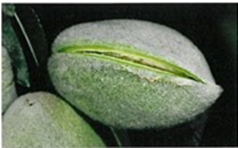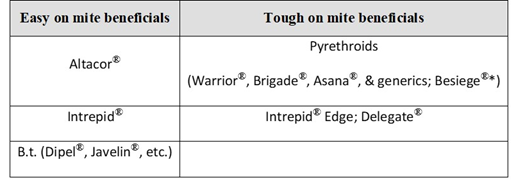Hull split and the pesticide application timing for navel orangeworm control on new crop nuts are fast approaching. Timing, coverage and pesticide selection, in that order, are critical to getting the best possible results from spray applications. Growers, working with their PCA(s), will make the decisions that work best for each operation. The following are a few suggestions/points to consider as the hull split season approaches.
- Careful monitoring of NOW from the spring through harvest is key to knowing when the next generation of NOW will appear. This information helps time insecticide sprays and shaking for best NOW control. Harvest and spray timing decisions should be based on local conditions. Varieties in the orchard, variable terrain, irrigation status, off-farm sources of NOW and other local factors should be part of the decisions to deliver the best quality crop possible.
- Timing of the first application (when Stage 2C is showing in the upper canopy) of navel orangeworm pesticides is critical with materials that target eggs and small larvae, such as Intrepid®, Intrepid Edge® and Altacor®. [The suture pops when squeezed at Stage 2C of hull split. See Figure 1]. From start to finish, hull split applications should take no more than a week.

Figure 1. Stage 2C of hull split. Time first NOW control application when Stage 2C is showing in the upper canopy of trees throughout the orchard.
- Consider NOW pesticides with limited to no harm on beneficial insects and mites. Spider mite control is expensive using knock down materials. A selective miticide can knock down spider mites as harvest approaches, leaving beneficials to help control spider mites. But, if the NOW insecticide tank mix damages the beneficial population, you are back to square one – hoping your miticide alone can get you through harvest without excessive leaf loss. The following is a partial list of materials registered for NOW control and their impact on some or all beneficials that help with mite control.
- NOW pesticide resistance management should be considered when selecting materials to help keep the materials active on the pest for as many years as possible. There are no new chemistries in the pipeline. Growers and PCAs should carefully steward the currently registered, effective materials. There are only two registered chemistries that offer effective, long term NOW control – methoxyfenozide (Intrepid®, Intrepid® Edge) and chlorantraniprole (Altacor®, Besiege®). Minecto®Pro contains cyantraniliprole, which is a different a.i. but is in the same IRAC group (28) as chlorantraniprole and should be lumped with it for resistance management considerations. The most careful resistance management program alternates chemistries for every spray. For example, Altacor® for the early hull split spray and Intrepid® for the second. Using the same chemistry for two consecutive generations is NOT resistance management. Two consecutive generations exposed to the same IRAC group, for example, Minecto®Pro for spring (“mummy”) spray and Altacor® for early hull split spray, is not recommended.
- Pesticide control with egg/small larvae materials (Intrepid®, Altacor®) will only provide at best, roughly 50% control compared to unsprayed trees. Hull splitting of nuts is a moving target between start of hull split and shake. Research results reporting 90-100% NOW control with pesticide sprays from air or ground are from a specific test and are meant for comparison purposes, NOT to suggest that growers will get that kind of NOW control with pesticide spraying alone. Given the rising NOW pressure in the Sacramento Valley over the last decade and the tough quality standards the market demands, spraying is only one part of effective NOW management. Sanitation and timely harvest, along with mating disruption, are critical parts of NOW management. Research results reporting 90-100% NOW control with pesticide sprays from air or ground are from a specific test and meant for comparison purposes, NOT to suggest that growers will get that kind of NOW control from with pesticide spraying.
- Timely harvest, as soon as an orchard reaches 100% hull split, is a critical part of NOW control. Nuts on the orchard floor are virtually invisible to NOW females. Often, 100% hull split is reached before the start of the 3rd generation of NOW or just as it begins. Not every block can be harvested ahead of the 3rd flight, but those that are will have less damage than those harvested later, under equal NOW pressure. For example, in the high damage year of 2017, the organic block at Nickels Soil Lab, with no NOW spray applied, had 0.7% NOW damage in Nonpareil nuts, sampled from the nut cart. Harvest occurred as the 3rd flight of NOW was just beginning.



Leave a Reply